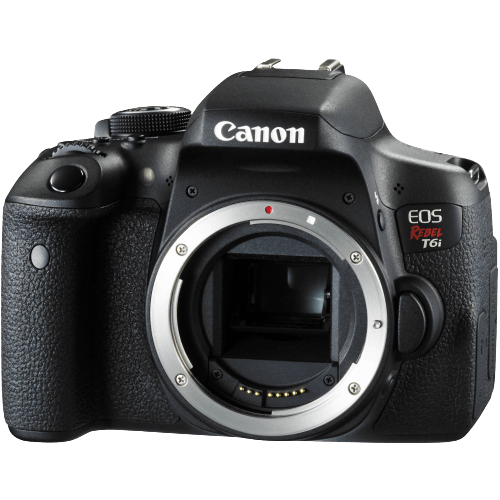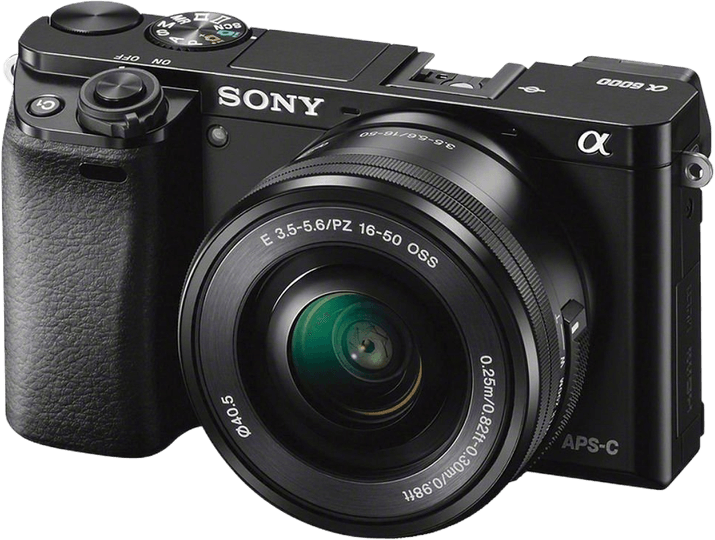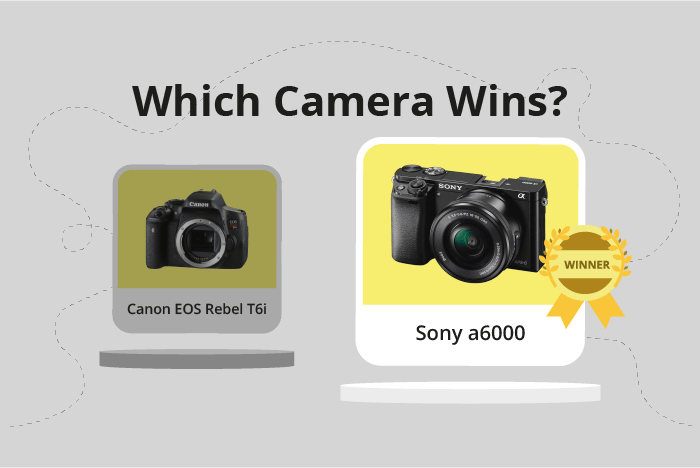Canon EOS Rebel T6i / 750D vs Sony a6000 Comparison
Canon EOS Rebel T6i / 750D

Sony a6000

The Sony a6000 narrowly edges out the Canon EOS Rebel T6i / 750D with a score of 57/100 compared to the Canon’s 56/100. Both cameras were released around the same time, with the Canon in 2015 and the Sony in 2014. They share some common specifications, such as their launch prices, which were $750 for the Canon and $799 for the Sony.
The Sony a6000 has the advantage of being a mirrorless camera, which contributes to its smaller size (120 x 67 x 45mm) and lighter weight (344g / 0.76lbs) compared to the Canon’s DSLR build (132 x 101 x 78mm, 555g / 1.22lbs). This makes the Sony a6000 more portable and easier to carry around.
On the other hand, the Canon T6i is a DSLR, which may appeal to those who prefer the traditional feel and handling of a DSLR camera. Its slightly larger size and weight can provide better stability for certain shooting situations.
Taking these factors into account, the Sony a6000 is the winner in terms of portability and compactness, while the Canon T6i might be more appealing to those who prefer the DSLR experience.
Canon EOS Rebel T6i / 750D vs Sony a6000 Overview and Optics
The Sony a6000 emerges as the winner in the optics comparison with a score of 67/100, while the Canon EOS Rebel T6i / 750D trails behind with a score of 59/100. Both cameras share several common specifications, including a 24-megapixel CMOS sensor, APS-C sensor size, and the absence of image stabilization. Despite these similarities, there are notable differences that contribute to the Sony a6000’s higher score.
The Sony a6000 boasts a superior DXOMARK sensor score of 82, compared to the Canon T6i’s 71. This higher score indicates that the Sony a6000 provides better image quality and low-light performance. Additionally, the Sony a6000 has a faster shooting speed of 11 frames per second (fps), doubling the Canon T6i’s 5 fps. This faster speed allows the Sony a6000 to capture fast-moving subjects with greater ease and precision.
On the other hand, the Canon T6i has the advantage of a more versatile lens mount, the Canon EF-S. This lens mount accommodates a wider range of lenses, providing photographers with more options to suit their shooting needs. However, this advantage does not outweigh the benefits provided by the Sony a6000’s superior sensor and shooting speed.
Taking these factors into account, the Sony a6000 proves to be the better choice in terms of optics. Its higher DXOMARK sensor score and faster shooting speed make it a more capable camera for capturing high-quality images in various conditions. While the Canon T6i offers a more versatile lens mount, this advantage is not enough to compensate for its lower performance in other areas.
Canon EOS Rebel T6i / 750D vs Sony a6000 Video Performance
The Sony a6000 outperforms the Canon EOS Rebel T6i / 750D in terms of video capabilities, with a video score of 56/100 compared to the latter’s 43/100. Both cameras share some common specifications, such as Full HD max video resolution and max video dimensions of 1920 x 1080. However, neither camera has built-in time-lapse functionality.
The Sony a6000’s higher video score is primarily due to its superior max video frame rate of 60fps, which is double the Canon T6i’s 30fps. This means that the Sony a6000 can capture smoother and more detailed video, particularly in fast-moving scenes or when recording action footage. This advantage makes the Sony a6000 a more suitable choice for users who prioritize video quality and performance.
On the other hand, the Canon T6i does not offer any specific advantage over the Sony a6000 in terms of video capabilities. Its lower max video frame rate of 30fps may be sufficient for casual video recording, but it will not provide the same level of detail and smoothness as the Sony a6000’s 60fps.
Considering the significant difference in video scores and the max video frame rate, the Sony a6000 is the clear winner in terms of video capabilities. Users who prioritize video performance should opt for the Sony a6000, while those who are content with casual video recording and primarily focus on photography can still consider the Canon EOS Rebel T6i / 750D.
Canon EOS Rebel T6i / 750D vs Sony a6000 Features and Benefits
The Canon EOS Rebel T6i/750D outperforms the Sony a6000 with a feature score of 57/100, compared to the Sony’s 41/100. Both cameras share some common specifications, such as a 3-inch screen, flip screen, lack of GPS, WIFI connectivity, and absence of Bluetooth. However, there are key differences that make the Canon T6i/750D a more feature-rich camera.
The Canon T6i/750D has a higher screen resolution of 1,040,000 dots, while the Sony a6000 features a screen resolution of 921,600 dots. This difference provides the Canon T6i/750D with a clearer and sharper display for better image preview and menu navigation. Additionally, the Canon T6i/750D has a touchscreen, which the Sony a6000 lacks. The touchscreen enables more user-friendly control and quick access to settings, making the Canon T6i/750D more convenient to use.
Despite its lower feature score, the Sony a6000 does have some advantages. Its compact body makes it more portable and easier to carry around for extended periods. However, this advantage does not outweigh the benefits offered by the Canon T6i/750D’s superior features.
In comparing the Canon EOS Rebel T6i/750D and Sony a6000, the Canon T6i/750D proves to be the better camera in terms of features. With its higher screen resolution and touchscreen capabilities, it offers a more enjoyable and user-friendly experience. While the Sony a6000 may have a compact design, it falls short in providing the advanced features found in the Canon T6i/750D.
Canon EOS Rebel T6i / 750D vs Sony a6000 Storage and Battery
The Canon EOS Rebel T6i / 750D outperforms the Sony a6000 in storage and battery with a score of 24/100 against 21/100. Both cameras have one memory card slot and do not support USB charging. They accept SD / SDHC / SDXC cards, with the Sony a6000 also compatible with Memory Stick Pro Duo / Pro-HG Duo cards.
The Canon T6i boasts a longer battery life, allowing for 440 shots compared to the Sony a6000’s 360 shots. The T6i uses an LP-E17 battery, while the a6000 utilizes an NP-FW50 battery. The additional memory card compatibility of the Sony a6000 is an advantage but does not outweigh the superior battery life of the Canon T6i.
Considering the storage and battery aspects, the Canon EOS Rebel T6i / 750D is the better option due to its longer battery life, which enables more shots per charge. While the Sony a6000 has the advantage of additional memory card compatibility, it falls short in battery performance.
Alternatives to the Canon EOS Rebel T6i / 750D and Sony a6000
Are you still undecided about which camera is right for you? Have a look at these popular comparisons that feature the Canon EOS Rebel T6i / 750D or the Sony a6000:

